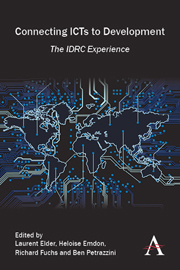Book contents
- Frontmatter
- Contents
- Acknowledgments
- Introduction Part I From Heresy to Orthodoxy: ICT4D at IDRC
- Introduction Part II From Beginning to End to Beginning Again
- Chapter 1 Catalyzing Access through Social and Technical Innovation
- Chapter 2 Catalyzing Access via Telecommunications Policy and Regulatory Research
- Chapter 3 Access to Knowledge as a New Paradigm for Research on ICTs and Intellectual Property
- Chapter 4 ICTs and Social Inclusion
- 5 Access and Usage of ICTs by the Poor (Part I)
- Chapter 6 Local Economic Opportunities and ICTs: How ICTs Affect Livelihoods (Part II)
- Chapter 7 Research on eHealth across Health Systems: Contributions to Strengthen a Field
- Chapter 8 Making the Grade: The Role of ICTs in Providing Access to Knowledge
- Chapter 9 E-Government for Development: ICTs in the Public Sector and the Evolving Citizen–Government Relationship
- Chapter 10 Innovations in Evaluating ICT4D Research
- Chapter 11 Conclusions: A Decade of Innovation that Matters
- Epilogue Into the Future: New Opportunities and Threats in a Global Networked Society
- Author Biographies
Chapter 1 - Catalyzing Access through Social and Technical Innovation
from Introduction Part II - From Beginning to End to Beginning Again
Published online by Cambridge University Press: 05 March 2014
- Frontmatter
- Contents
- Acknowledgments
- Introduction Part I From Heresy to Orthodoxy: ICT4D at IDRC
- Introduction Part II From Beginning to End to Beginning Again
- Chapter 1 Catalyzing Access through Social and Technical Innovation
- Chapter 2 Catalyzing Access via Telecommunications Policy and Regulatory Research
- Chapter 3 Access to Knowledge as a New Paradigm for Research on ICTs and Intellectual Property
- Chapter 4 ICTs and Social Inclusion
- 5 Access and Usage of ICTs by the Poor (Part I)
- Chapter 6 Local Economic Opportunities and ICTs: How ICTs Affect Livelihoods (Part II)
- Chapter 7 Research on eHealth across Health Systems: Contributions to Strengthen a Field
- Chapter 8 Making the Grade: The Role of ICTs in Providing Access to Knowledge
- Chapter 9 E-Government for Development: ICTs in the Public Sector and the Evolving Citizen–Government Relationship
- Chapter 10 Innovations in Evaluating ICT4D Research
- Chapter 11 Conclusions: A Decade of Innovation that Matters
- Epilogue Into the Future: New Opportunities and Threats in a Global Networked Society
- Author Biographies
Summary
The main goal of the International Development Research Centre's (IDRC's) “Information and Communications Technologies for Development” (ICT4D) program was to harness information and communications technologies (ICTs) for the benefit of all citizens of developing countries. Increased access to ICTs was recognized as a means to a greater end – building an inclusive knowledge society and economy in the developing world. Yet it was also recognized that a non-uniform spread of ICTs was contributing to a persisting and, in some cases, widening gap between the information “haves” in more developed countries and the information “have nots” in less developed regions of the world (Sciadas 2005).
IDRC's ICT4D program aimed to mitigate the persisting inequality in access to ICTs. It first addressed connectivity to ICTs, or the so-called “first order digital divide” (Riggins and Dewan 2005). Second, it tackled access from the standpoint of the ability to use ICTs and to contribute content, the so-called “second order digital divide” (Brotcorne et al. 2010; Hargittai 2002). (See Box 1.1.) This chapter describes the work of IDRC and its partners in overcoming the first order digital divide by way of social and technical innovation.
For the first order digital divide, the driving idea behind the program was to demonstrate how social and technical innovations could be adopted and adapted in the developing world so as to catalyze access and therefore bring about socioeconomic dividends for disadvantaged populations. Throughout its history, IDRC's ICT4D program sponsored an extensive range of research on numerous ways to increase access to ICTs in the less developed regions of the world.
Information
- Type
- Chapter
- Information
- Connecting ICTs to DevelopmentThe IDRC Experience, pp. 27 - 56Publisher: Anthem PressPrint publication year: 2013
